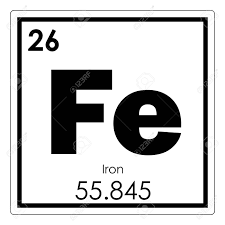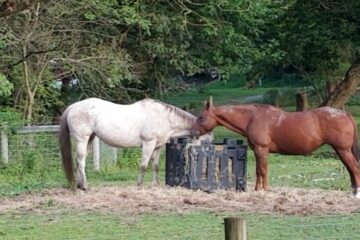Iron and Laminitis in Horses

In the past year or two Iron has become the bad guy in equine nutrition since soy, wheat mids and GMO ingredients have been degraded to juvenile delinquents.
Iron is blamed for thrush, poor hooves, bad coats and a host of other conditions none of which can be laid on the doorstep of iron.
I was surprised to learn just this past week that iron causes laminitis. Really?
This idea seems to be spreading rapidly in the horse world and particularly among those concerned with insulin resistance in their horses. Of course, there is no basis in research or reality for this idea. It has arisen out of a conflated misinterpretation of a paper written by a prominent clinical member of the ECIR world.
This conflation was propagated by a short article posted on another laminitis cause’s website by an author who obviously didn’t do a spittles drop of fact checking before hitting the “submit” button.
It is time for me to do my part in putting this nonsense to rest, at least until someone presents research data to revive the zombie.
Let me begin by stating again what I have stated at least a thousand times to anyone who brings up “iron overload”. It isn’t a thing. Because iron is in everything, horses have evolved an excellent iron management system.
The iron in a horse’s natural diet has a bioavailability of 20% or less, which means that a very small fraction of iron ingested is actually absorbed by the horse. In fact, the availability of dietary iron is so low for horses that they recycle the iron in their blood.
There are extremely few documented cases of iron toxicosis in horses from a naturally occurring source. The few cases that have been noted resulted from large doses of iron supplement. Indeed, horses are far more likely to be anemic.
Flaky hooves, thrush, coat fading and other issues attributed to iron overload and corrected by introducing zinc and copper to “balance” iron were actually more likely to be caused by a deficiency in zinc and copper than an overload of iron.
I have had this discussion with five different equine nutrition PhDs and a clinician at UC Davis. There is no issue with iron. Zero. It’s settled science.
To remind everyone again; I am NOT a scientist or clinician. I am a layperson who relies upon a trusted group of professionals to answer my questions and point me at the appropriate research. I don’t have any theories because I am not qualified to formulate my own theories. I do have some credentials in my wheelhouse that give me the ability to carry my own end of a conversation with equine PhDs. Holding commercial pilot certifications and designing network security technology for thirty plus years helps.
Now, where in the world did this belief that iron causes laminitis originate?
In 2019 Elanor Kellon VMD and Kathrine Gustafson, PhD published a paper documenting a data study that observed a POSSIBLE link between serum ferritin and insulin levels in insulin resistant horses. No correlation with laminitis is mentioned.
It is titled “Possible dysmetabolic hyperferritinemia in hyperinsulinemic horses”.
I’m just going to cut to the chase here and skip to the end of the paper…
“We recognize limitations to this retrospective analysis. This was not a prospective, controlled study comparing age-matched groups with and without hyperinsulinemia. The existing evidence investigating the bidirectional relationship between iron and hyperinsulinemia in horses is extraordinarily limited despite considerable scientific inquiry in other species. To the authors’ knowledge, Nielsen et al. (2012) is the only controlled study that used an equine model, but as a proxy for captive rhinos. A controlled, prospective study of sufficient power using dynamic tests of insulin sensitivity, diet control and analysis, iron indices, and inflammatory markers or other factors influencing ferritin is needed to disentangle the complex relationship between insulin and iron in the horse.”
There really isn’t a need for any further study to disentangle anything. Insulin resistance in horses has been extensively studied and the consensus is that the same metabolic function causing insulin dysregulation in horses is the same mechanism that causes elevated ferritin levels. In any case, dietary iron conclusively does not play a role in insulin dysregulation or laminitis.
“While even severe iron overload can occur in horses without evidence of metabolic syndrome (Theelen et al., 2019), iron is unlikely to be an independent causal factor…”
The study found no correlation between iron and laminitis. In fact, laminitis isn’t mentioned in the entire paper.
I might add based on the statistical formulae used to determine a linear correlation between insulin and ferritin the correlation is a low moderate. An “r” factor of 0.34 is just above the moderate correlation factor, the limit being 0.3. Below 0.3 it is a “poor” correlation.
In addition, the Pearson Correlation formula is very limited and does not make any allowance for variables ignoring many other factors in determining a correlation.
While we are here I’d like to use this as a teaching opportunity for other laypeople to understand what to look for when they are overwhelmed with the technical scientific terms and some questions to ask.
It is important to note that neither of the authors hold PhDs in equine nutrition. This in no way disqualifies or diminishes their work in any way. The paper was based on sound methods and is completely transparent. However, for me anyway, it is a consideration since five equine PhDs I’ve discussed this with are all on the same page. Dr. Kellon is a well known VMD while Dr. Gustafson holds a PhD in Visual Electrophysiology for humans.
Thirty-three horses were selected from the ECIR database based on their documented case histories as provided by their owners. Dr. Kellon is a fixture of the ECIR group so it is no surprise that this would be a source for data points. All of the horses were diagnosed with insulin resistance and confirmed with blood sampling. The authors state that all the subjects were insulin resistant and no control group data of “normal” horses was available.
These thirty-three samples were not taken in a controlled research laboratory environment. The samples were provided by members of the ECIR group after being obtained by their veterinarians.
Since any good study requires some form of control group of “normal” horses, the authors chose to use a 2012 study, “A potential link between insulin resistance and iron overload disorder in browsing rhinoceroses investigated through the use of an equine model” which tried to determine why many captive rhinos suffered from laminitis.
This study found that elevated levels of insulin correlated with elevated levels of ferritin.
Ferritin is not iron. It is a protein that binds iron and transports it to the liver for storage.
I’m not going into the whole ferritin, hepcatin, yadda, yadda equine iron management system. Several great equine PhDs have explained it much better than I would ever be able to.
Here’s a great one: https://www.horsejournals.com/horse-care/feed-nutrition/iron-equine-diet
Here’s a good one on copper and zinc: https://thehorse.com/19784/trace-mineral-basics-zinc-and-copper/
The other study mentioned and it’s probably the one most cited by the “iron bad” crowd is Theelen et al. 2019.
The fact that this study is cited at all confounds me as a layperson. Twenty-one horses and a donkey in The Netherlands showed signs of iron toxicosis in coat and hoof quality. They had been drinking water containing high levels of iron for an extended period of more than nine years.
Transferrin levels were elevated which only indicates high levels of iron in the diet. Post mortems of the horses that died during the study showed signs of high iron levels in liver, spleen and other organs.
Since the liver and spleen are the primary organs for storing and filtering iron it should come as no surprise that a thirty year old horse drinking water with high iron levels for a minimum of nine years might have some extra iron in its organs.
Nowhere does this study indicate that iron was a primary cause of death or debility of any of these animals. Certainly laminitis is not mentioned.
In addition, the study provides no baseline measurements of the environmental iron. No mention of feed protocols.
The study is simply bad science.
So, why does all this get me worked up?
Well, for starters any bad, mythological, conflated or otherwise misguided advice makes me crazy. Horse owners have enough to worry about without running down every rabbit hole that pops open.
This is particularly true for people who are dealing with metabolic horses. There is enough on our plate to manage without worrying about anything that is nothing.
As the concerned owner of a metabolic heart horse I would be at the top of the list of people wanting to know about a relationship between iron and laminitis. It is one of the reasons I took such an interest in this when it appeared a year ago.
Finally, iron is so ubiquitous in forage and feed ingredients that removing the “added” iron from a feed or balancer would be like withholding a tablespoon of salt from the ocean.
As far as I’m concerned, monitoring iron intake and paying for supplements to “handle” iron in horses should be thrown on the pile of all NSC must be lower than 10%. Impractical and unnecessary.
This isn’t just my opinion. It is science. No settled science supports a relationship between laminitis and iron. Likewise, no settled science supports iron toxicosis in horses from any natural dietary source of iron. The opposite is true. All settled science tells us that iron overload doesn’t occur in horses unless it has been induced by over supplementation
Stop trying to second guess the nutritionists who specialize in making our horses healthy. Iron is added to feeds and balancers for a reason. The majority of horses do not get enough.
There is no relationship between iron in a horse’s diet and laminitis. None. Not as a causal factor nor as a contributor.


